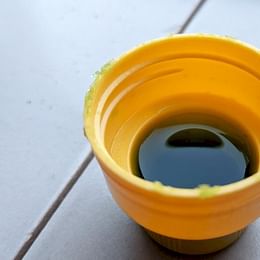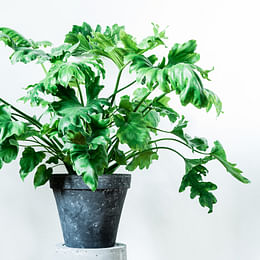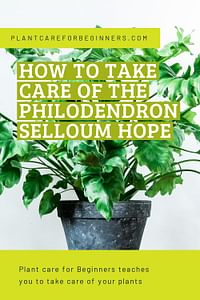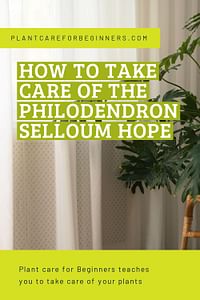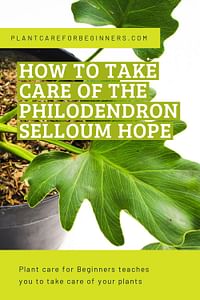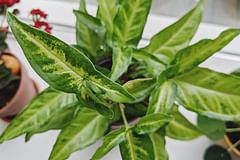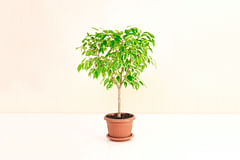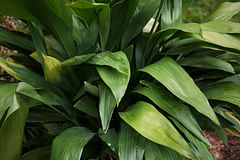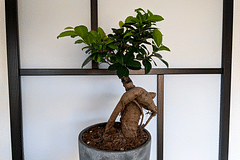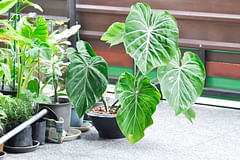How to Take Care of the Philodendron Selloum Hope
Are you a beginner when it comes to taking care of plants and did you just get a Philodendron Selloum Hope? Learn how to properly take care of the Philodendron Selloum Hope with this easy-to-follow plant care guide!

If you're new to plants and you're looking for an unusual plant, try the Philodendron Selloum! This plant is also known as the Philodendron Hope. It's a beautiful and easy-to-care-for plant that can add a touch of greenery to any room. In this plant guide, we'll look at how to take care of your Philodendron Selloum so that it stays healthy and happy!
The Philodendron Hope is a unique-looking plant with textured and unusual-looking leaves. These leaves will bring a new sense of adventure to any room in your house, trust me. These plants can grow quite large, so make sure you have plenty of space for them to spread out.
In this plant care guide, we're going to look at how you can help your Philodendron Hope thrive. These are the aspects of its plant care needs that we'll look at in this guide:
By the end of this guide, you'll be an expert on taking care of your Philodendron Hope! So let's get started.
Watering your Philodendron Hope
Watering your plant is one of the most important parts of taking care of any plant. Get it right and your plant grows well and looks healthy, but get it wrong and it could die in a matter of days. So, how often should you water your Philodendron Hope?
The answer isn't a straightforward number of days, but it depends on several things. Things like the size of your plant and the pot it's in, as well as the type of soil, make a big difference. You should water a plant in a small pot with drainage holes less often than a plant in a large pot without drainage holes. And the type of soil also makes a big difference. If you're using a well-draining potting mix, your soil will dry out more quickly than if you added peat moss or vermiculite.
So rather than telling you to water it once per week, I'd like you to check the soil every few days. These plants love growing in moist, but not soggy soil. Water your plant when the top 2-5 cm (1-2 inches) of soil feels dry to the touch. In the summer this will happen sooner than in the winter, so check the soil every few days to see if it's dry yet.
On average, you should water this plant once per week in the summer and once every 10-14 days in the winter. You can use this range as a starting point, but make sure to check the soil every few days to see when your plant is thirsty.
What are the signs of overwatering or underwatering a Philodendron Hope?
Both overwatering and underwatering a Philodendron Hope can be bad for its health. If you're unsure if you're dealing with overwatering or underwatering, you can look for these signs.
Signs of Overwatering
If you see that the leaves of your Philodendron Hope are turning yellow, it might be a sign of overwatering. Most often, yellowing occurs due to too much water.
Another sign of overwatering is when the leaves feel soft and mushy. This is a clear sign that the plant has gotten too much water.
The last clear sign is when the leaves start wilting but the soil isn't dry. This can be a symptom of overwatering. New leaves may also turn brown and soft, indicating too much water.
Signs of Underwatering
The first sign of underwatering is when the leaves start to get brown tips. The leaves won't get enough moisture from the stems and will dry out. You'll see this first at the tips and it'll move towards the edges and the rest of the leaf afterward.
If the leaves start to droop and the soil is dry, it's time to water your Philodendron. The leaves will start to get crispy after this, so by watering the plant soon, you'll help it to stay healthy.
To avoid these issues, it's important to find a balance with watering. It's better to underwater than overwater because too much moisture can lead to root rot.
The best sunlight exposure for your Philodendron Hope
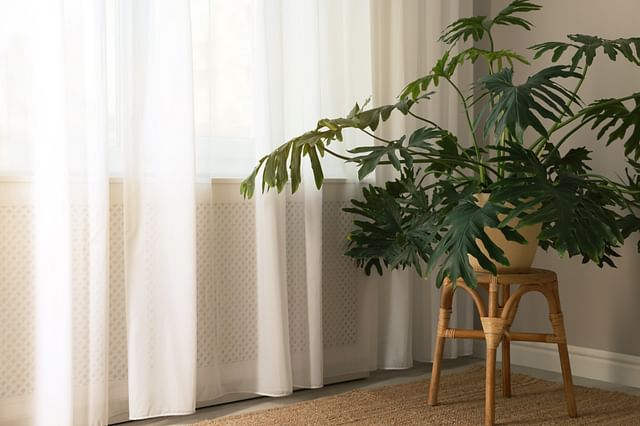
The Philodendron Selloum is a tropical plant, so it likes warm temperatures and humid conditions. These plants are native to South America, where they grow on the ground in the rainforest.
In its natural habitat, the Philodendron Selloum gets indirect sunlight as it grows beneath the canopy of tall trees. This is the type of light exposure that your Philodendron Hope will do best in.
You can give your Philodendron Hope bright, indirect light by placing it by a west- or south-facing window. If you don't have a spot like this in your home, you can also grow your Philodendron under artificial light, like an LED grow light.
You know your Philodendron has gotten too much sunlight when you see the color on the stems or leaves change. This could also mean your plant has gotten too much water, so make sure to check the soil moisture levels first.
If you'd like to learn the signs of too much sunlight and what to do to help your plant recover, read "What are signs of too much sunlight on plants?".
Temperature and humidity
The ideal temperature for a Philodendron Hope ranges from 18 to 27 degrees Celsius (65 to 80 F). It's important to avoid sudden temperature changes to keep the plant stress-free. Philodendrons are very sensitive to cold drafts or heating vents. When they're exposed to these temperature changes, it can lead to damage to their leaves. Always try to maintain a consistent temperature environment.
During the winter, be careful to not let the temperatures go below 15 degrees Celsius (59 F). These colder temperatures can harm the plant if it has been too cold for too long.
You should try to keep humidity levels between 60% and 80%, as this is what it gets in nature too. If you notice leaves browning and curling, it might be a sign that the environment is too dry. If you're not sure if the humidity levels are high enough, you can use a hygrometer to check the levels.
During the winter, or if you live in a very dry climate, you can still take care of this plant. You'll need to help it by placing a humidifier near the plant or creating a pebble tray filled with water. This will keep the humidity levels high. Regular misting can also help but don't overdo it. Too much moisture on the leaves can lead to fungal diseases.
The best type of soil for your Philodendron Hope
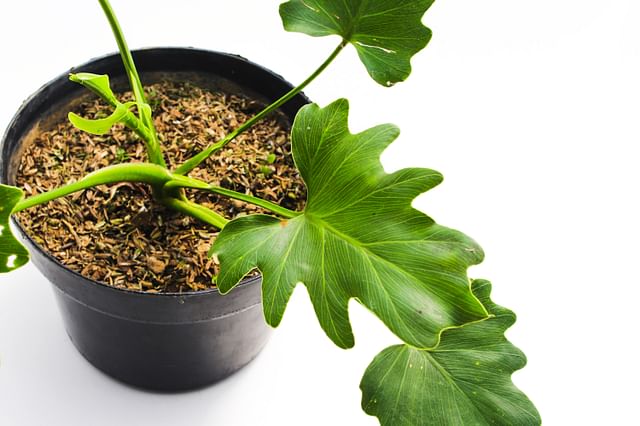
Watering and sunlight are very important parts of taking care of your plant, but the soil is a close third! The type of soil you use can make a big difference in how well your plant grows.
The Philodendron Hope prefers a well-draining potting mix that's full of organic matter. This type of soil has plenty of materials to help hold moisture. It also drains excess moisture so that your plant doesn't sit in wet, soggy soil. You can make your own mix by combining one part potting soil, one part peat moss, and one part perlite. Or you can buy a pre-made potting mix for philodendrons at your local garden center.
This type of soil holds water for several days but still provides excellent drainage. This soil creates the perfect growing environment for your Philodendron Hope.
How often do you fertilize your Philodendron?
We've already looked at 3 important things to keep your Philodendron Hope healthy. To help it grow faster and stay healthy throughout the year, you'll need to fertilize your plant. You can either use a liquid fertilizer or a slow-release fertilizer. I recommend using a liquid fertilizer because it's easy to control the dosage. This will help you to avoid overfertilizing. When you use a liquid fertilizer, apply it once per month during the growing season.
During the winter, when your plant is dormant, you shouldn't fertilize your Philodendron Hope. Your plant plant won't need the fertilizer during this time of year. If you choose to fertilize your plant in the winter, you're very likely to overfertilize your plant, which could cause root damage. You can start to fertilize your plant again at the end of February, right before the spring starts.
Specific types of fertilizers
Philodendron Hope is a plant that does best when you apply a balanced fertilizer to it. A fertilizer with 3-1-2 (NPK) will give your jungle plant the nutrients it needs to stay healthy.
There are several different types of fertilizers you can use for your Philodendron. The one I recommend to anyone is a liquid fertilizer. This is a fertilizer that you add to the water you use to water your plant.
If you're one to forget to fertilize your plant, you could also use a slow-release fertilizer. This type of fertilizer will feed your plant for about 3 months, so you'll only have to apply it twice per year. You'll have to apply it at the beginning of spring and again at the beginning of summer.
No matter which you choose, remember to follow the instructions on the package. Over-fertilizing can lead to excess salt build-up in the soil, which could harm the plant. All fertilizers have different concentrations, so dilute them according to the instructions.
Pruning and trimming your Philodendron Hope
You should prune your Philodendron Hope when it needs it. The best time to do so is during spring or early summer when the plant is growing. This can help maintain its shape and remove any dead or damaged leaves. Pruning also encourages new growth and improves the health of your plant.
When you start pruning your Philodendron, it's important to wear gloves. After you're done, make sure to wash your hands and tools to prevent any irritation from the plant's sap.
Pruning a Philodendron Hope is a straightforward process. Here's how you do it:
Prepare your tools
Before you start, have a sharp, clean pair of pruning shears or scissors. It's important to sterilize your tools to prevent the spread of disease. You can do this using rubbing alcohol.
Identify what needs pruning
Look for yellow, brown, or wilted leaves. These are the parts you want to remove. Also, if the plant is becoming too large for your space, identify the areas where you'd like to reduce its size.
Make the cut
Cut the unwanted leaves or stems at the base where they connect to the main stem. Always aim to cut at a 45° angle to promote better healing.
Remove flower spikes
If your Philodendron Hope has bloomed and the flowers have faded, you can prune the flower spikes back. These spent flowers will only use energy from the plant, so pruning them is a good idea. By pruning them, you'll give the plant some extra energy to grow new leaves.
Clean up
After pruning, clean up the fallen leaves and stems. They could have pests or diseases. Always wash your hands after handling the plant to avoid skin irritation from the sap. Make sure to clean your tools with some rubbing alcohol as well.
(Optional) Propagation
If you've pruned any healthy stems, you can use these for propagation. We'll look at this step more in one of the next sections.
When should you repot your Philodendron Hope?
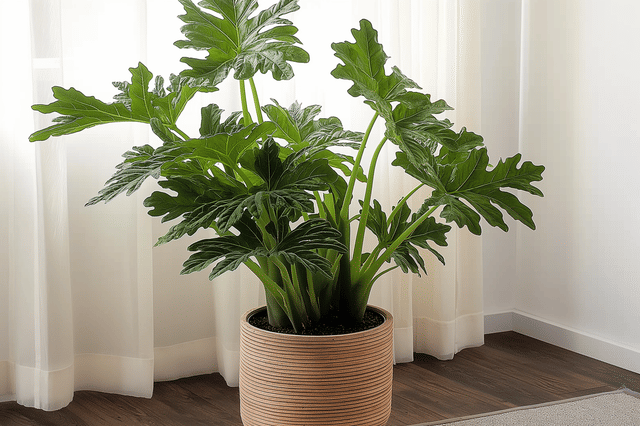
As your Philodendron Hope grows, you will need to repot it into a larger pot at some point. When you don't repot your plant, you'll see the growth of your Philodendron slow down over time. The plant will take over the whole pot and can't find new spots in the soil to absorb nutrients from. You can check if it's time to repot by lifting the plant out of the pot and checking if the roots are circling the bottom of the pot. If you see this, your plant is ready for a bigger pot.
The best time to repot your Philodendron Hope is in the spring before new growth begins. When you're ready to repot your Philodendron, choose a pot that's only one or two sizes larger than the current one. If you're using a pot that's larger than this, you're more likely to overwater your plant. Be sure to use fresh potting mix and water well after transplanting. This new soil will give your Philodendron extra nutrients to grow.
Remember, it's important to wear gloves and wash your hands after handling the Philodendron Hope. The sap can cause skin irritation.
How often should you check for rootbound conditions in a Philodendron Hope?
On average, a Philodendron Hope outgrows its pot every 2 years. Because of this, I recommend you check for rootbound conditions a little more often than that. If you check your plant every 1.5 years, you'll be on time for repotting your plant.
Your plant is rootbound when its roots take up more than half the space in the pot and start circling the bottom. But, you can also look at changes in your plant's appearance.
Signs that your Philodendron Hope may be rootbound include yellowing or mushy leaves. Your plant may also seem to struggle without a real explanation. If you think your plant may be rootbound, remove it from its pot to check the root system.
How do you propagate your Philodendron?
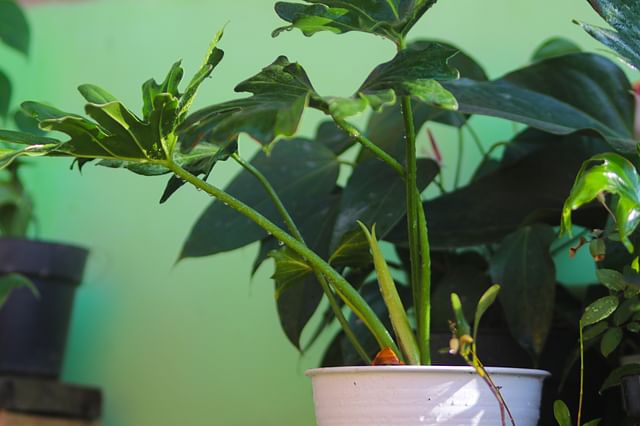
You can propagate your Philodendron Hope by division or stem cuttings. Propagating stem cuttings is the easiest way to propagate this plant and puts the plant at the least risk of any problems.
Stem cutting propagation
You can propagate the Philodendron Hope by taking a stem that has two or three leaves and cutting it off below a node. A node is a thicker part of the stem. The new roots will start to grow out of these roots if they haven't already.
After you've cut the stem, you can place it in water. This is what we call "water propagation". After a few weeks, you'll start to see roots grow. When these roots are at least 5 cm (2 inches) you can move your stem cutting to a pot with soil or Leca and you'll have propagated your plant!
Division propagation method
Division propagation is another method to multiply your collection of Philodendron Hope. This technique is useful when you have a mature plant you can separate into multiple sections, each with its own root system. Here's how you do it:
Take your plant out of its pot, being careful not to damage its roots any more than necessary. You can now check the root ball and find natural separations between groups of stems and their roots.
Using your hands or a clean, sharp knife, to divide the plant into smaller sections. Make sure that each new section has a healthy set of roots and at least one or two leaves. After separating the plants, plant each of them into its own pot with well-draining potting soil.
Through division, you can easily double or even triple your Philodendron Hope collection. Each division will grow into a new, full plant over time.
Is the Philodendron Hope toxic to pets or children?
Philodendrons are beautiful plants from the rainforest. Like many other tropical plants, this Philodendron Hope is toxic to pets and children. This plant contains calcium oxalate, which can cause pain, swelling, and drooling if ingested. In more severe cases, ingestion can even be fatal. These problems can also start when coming into contact with the sap of the plant.
Because this plant is toxic, it's best to keep these plants out of reach of children. If they're old enough, you can teach your kids about the dangers of ingesting parts of this plant. If you see chew marks or know your pet or child has eaten from this plant, make sure to call your veterinarian or doctor right away!
Precautions for pets
Because this plant is toxic to pets, it's important to take a few steps to protect both your pets and the plant.
The easiest way to avoid problems is by placing the plant in a location where your pets cannot reach it. This could be on a high shelf or in a room that your pets don't have access to.
If you keep this plant in a room your pets can get to, regularly check if any leaves have fallen to the ground. Even fallen leaves can lead to poisoning if your pets accidentally eat them. The same goes when you handle your plant. This could cause leaves to fall. Don't leave them on the ground, but clean them up right away.
The plant's toxicity is usually mild and not life-threatening, but it can still cause discomfort to your pet. So to be completely safe, keep it away from your pets.
Common pests
Several pets and diseases can attack your Philodendron Hope. Common pests that infest this plant include aphids, mealybugs, scales, and spider mites. To fight these unwanted guests, it's important to act right away.
Spotting pests
Aphids look like tiny green, white, or black bugs. You can find them in clusters on new growth or the undersides of leaves. Mealybugs look like small, cottony spots that tend to gather in leaf axils and stem junctions. Scales are brown or tan bumps that stick to stems and leaves. You can spot Spider mite infestation through the presence of webbing on the plant.
Treating pests
If you see any of these, isolate your Philodendron Hope immediately. This will help to prevent the pests from spreading to other houseplants. You can start treating your plant by removing pests using a soft cloth or a gentle stream of water. For bigger infestations, use insecticidal soap or neem oil. If these don't work, you can try a stronger chemical pest spray.
Always follow the instructions on the label of the product you've gotten. On average, you should treat your plant once every 7-10 days until the pests are gone.
Preventing pests
The best way to prevent pests is to keep the leaves dust-free and keep your plant healthy. Most pests take advantage of weakened plants. You should also regularly inspect your plant for any pests to catch any issues early on.
Common diseases
When it comes to diseases, Philodendron Hope is prone to root rot and bacterial blight. These diseases are usually caused by overwatering or poor drainage. Root rot can cause the leaves to turn yellow, brown, and even drop. This often starts from the lower leaves and progresses upwards.
Another issue, bacterial blight, can cause discolored spots on the leaves. Overwatering or high humidity can also lead to yellowing leaves, often accompanied by patches of brown. It's important to check your plant for these signs to make sure it stays healthy.
Tips for preventing leaf yellowing or browning
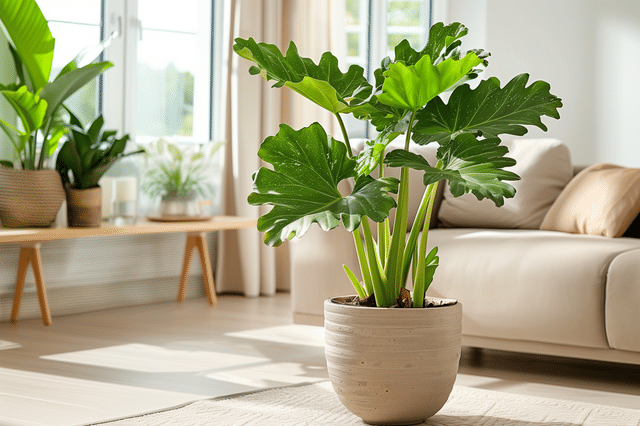
Leaf yellowing or browning in Philodendron Hope can be scary. These symptoms can happen from a variety of environmental or care issues. With a few simple steps, you can keep your plant healthy and prevent these problems.
Overwatering or underwatering is a common cause of yellowing and browning leaves in Philodendron Hope. Make sure to water the plant only when the top inch of soil is dry. Make sure the pot has good drainage to prevent waterlogging.
Keep the Philodendron Hope in bright, indirect light. Too much direct sunlight can cause leaf burn, leading to browning of the leaves.
Philodendrons love high humidity (60 to 80%) and temperatures between 18 and 27 degrees Celsius (65 and 80 F). If the air is too dry, it can lead to leaf browning. Increase the humidity if it's dry and keep the plant away from cold and hot drafts in your house.
Too much or too little fertilizer can also cause yellowing leaves. For the best result, always follow the instructions on the fertilizer packaging. This will help to keep your plant healthy throughout the year.
Remember, some older lower leaves naturally turn yellow and fall off as part of the plant's growth. This is completely normal and isn't an issue as long as your plant is growing new, healthy leaves as well.
Is it necessary to clean the leaves of a Philodendron Hope?
It's necessary to clean the leaves of a Philodendron Hope. Wiping the leaves with a damp cloth helps keep them free of dust and pests. This can improve the plant's health by allowing more light to reach the leaves, enhancing photosynthesis. It also improves the aesthetics of the plant by keeping the leaves shiny and vibrant.
Avoid using a feather duster to clean the leaves, as it can easily transfer tiny pests from one plant to another. Also, try to avoid overhead watering to keep the leaves dry and prevent rot and disease.
Conclusion
The care tips in this guide help you to make sure your Philodendron stays healthy and vibrant. Together, we've looked at watering, lighting, humidity, and pest management. Also, don't forget to clean and prune its leaves to keep it looking its best and avoid problems.
Whether you're a seasoned plant parent or a new plant owner, your Philodendron Hope will always reward your care. Now that you know all the basics of taking care of your Philodendron Hope, it's time to put this knowledge into practice! Share this guide with your friends and family so they can take care of their plants, too.
If you have more questions about taking care of your Philodendron Hope or other philodendrons, feel free to e-mail me. I'm always happy to help!
Thank you for reading this post! I hope it helps you to keep your plants healthy and beautiful! If you're looking for more guides on specific plants, you can always request a plant guide to get a guide for the plant you have trouble with.
Test your plant care knowledge
Quiz completed!
Want to learn more? Sign up for my newsletter to receive free tips in your inbox!
Sign up now!